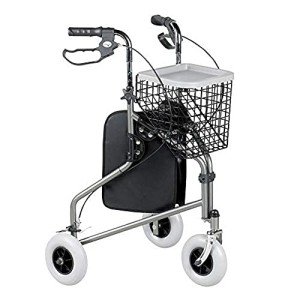12 Facts About Rollator Walker That Will Refresh Your Eyes At The Water Cooler
Rollator Walker Safety: A Comprehensive Guide
As people age or face mobility obstacles due to health problem or injury, preserving independence often ends up being a concern. Rollator walkers, supplying both support and mobility, have actually ended up being vital tools for lots of. However, while they use numerous benefits, guaranteeing safety while using a rollator walker is paramount. This post provides extensive insights into rollator walker safety, including best practices, typical dangers, and vital suggestions for users and caregivers.
Comprehending Rollators
A rollator walker is a mobility gadget with wheels that enables people to walk with the assistance of a frame. Unlike basic walkers, rollators normally feature:
- Three or 4 wheels for much easier maneuverability
- Hand brakes for stopping and managing speed
- A seat for resting when needed
- Storage compartments for carrying personal items
These functions make rollators ideal for both indoor and outdoor use, improving the quality of life for users by providing a sense of self-reliance.
Benefits of Using Rollator Walkers
- Increased Mobility: Rollators can help users in moving safely and conveniently.
- Support and Stability: With a sturdy frame and brakes, they provide vital support when standing or walking.
- Convenience: Many rollators included padded seats, permitting users to rest as needed.
- Convenience: Integrated storage solutions can carry essential items, releasing hands for much better balance.
Common Hazards Associated with Rollator Walkers
While rollators can improve mobility and safety, they can also posture dangers. Users need to know potential risks to decrease accidents:
- Uneven Surfaces: Rollators might tip over if utilized on uneven or sloped terrain.
- Braking Issues: Failing to engage the brakes adequately can result in falls.
- Excess Weight: Overloading the storage compartments can impact stability.
- Incorrect Use: Not making use of the rollator as meant can result in mishaps.
- Poor Maintenance: Neglecting regular look at wheels and brakes could cause failure during use.
Rollator Walker Safety Tips
To improve safety while using rollator walkers, consider the following pointers:
1. Proper Fit and Adjustment
- Height Adjustment: Ensure that the manage height is set to the user's wrist level when standing upright. An appropriate fit motivates much better posture and control.
- Seat Height: If the rollator has a seat, guarantee it's comfortable and accessible for resting.
2. Regular Maintenance
- Examine Brakes: Make sure hand brakes are working properly. Adjust or replace them if essential.
- Inspect Wheels: Regularly check wheels for wear and tear, and guarantee they spin freely.
- Take a look at Frame: Check for loose screws or cracks in the frame to ensure it remains sturdy.
| Maintenance Task | Frequency |
|---|
| Brake inspect | Weekly |
| Wheel evaluation | Month-to-month |
| Frame examination | Regular monthly |
3. Environment Awareness
- Clear Pathways: Keep living spaces devoid of clutter and barriers that might posture a tripping hazard.
- Lighting: Ensure that areas are well-lit to avoid mistakes, specifically throughout night hours.
- Avoid Slippery Floors: Be careful on damp or waxed floors, as they can lead to falls.
4. Safe Walking Techniques
- Engage Brakes When Stopping: Always engage brakes before sitting or while resting.
- Use Proper Walking Technique: Move gradually and maintain a consistent speed, taking actions that match the rollator's width.
- Balance While Turning: Turn carefully, utilizing the rollator for support as needed.
5. Seek Assistance
- Involve Caregivers: Encourage household members or caretakers to assist in navigating challenging surfaces or scenarios.
- Take Advantage of Community Resources: Many neighborhoods use mobility training for those utilizing walk-assisting devices.
Frequently Asked Questions about Rollator Walker Safety
Q1: How do I choose the best rollator walker?
When selecting a rollator, think about the user's weight, height, and intended use. It's also necessary to look for functions such as hand brake effectiveness and wheel size, which can impact maneuverability.
Q2: Can I use a rollator walker on irregular surface areas?
While rollators can deal with a range of surfaces, it is best to avoid steep inclines, gravel, or cobblestones, as these can be harmful. Stick to flat, smooth surface areas whenever possible.
Q3: How can I avoid falls while utilizing a rollator?
Engaging the brakes when sitting, keeping paths clear, adjusting your rollator for the proper height, and being conscious of your surroundings can greatly minimize the risk of falls.
Q4: Are all rollator walkers the very same?
No, rollators can be found in different types and sizes, created for different needs. Some may have additional accessories like baskets, while others are lightweight or feature a higher weight capability.

Q5: Is it safe to carry bags on a rollator?
Always be mindful of the weight limit and distribution of the load. Use the rollator's designated storage services and prevent straining it.
Rollator walkers are vital devices that improve mobility and promote self-reliance for users facing mobility challenges. However, guaranteeing safety while using these gadgets is important. By understanding potential dangers, sticking to safe practices, and maintaining the walker frequently, users can delight in the benefits of their rollator with decreased risk. Ultimately, the goal is to help with self-confidence and stability, enabling individuals to browse their world with security and ease. As care service providers, household members, and communities focus on safety, they empower users towards a better, more independent quality of life.


